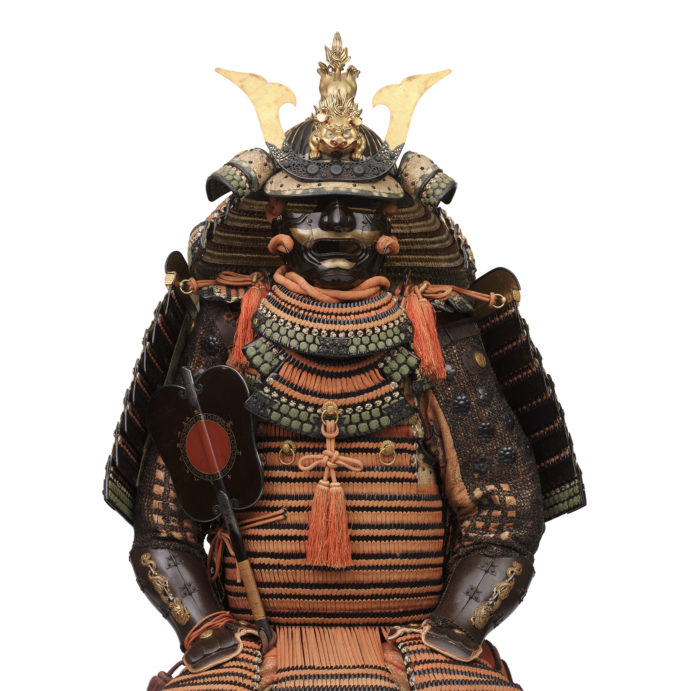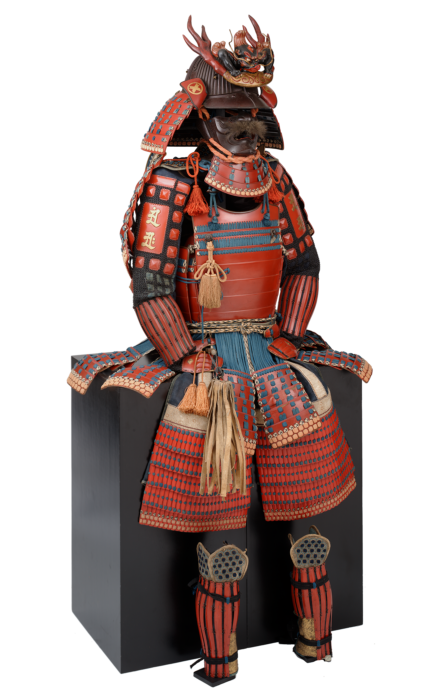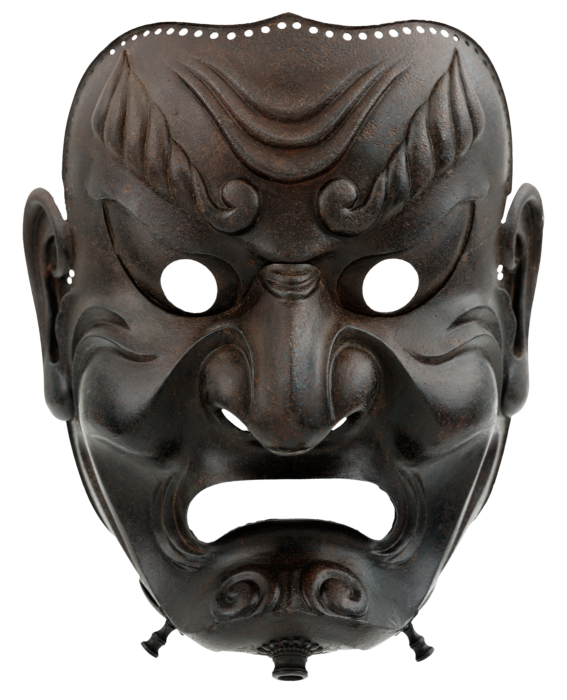
Pieces in this suit of armor date from 1400 to the 18th century. All images courtesy The Ann & Gabriel Barbier-Mueller Museum, Dallas. Photos by Brad Flowers
“Samurai” has arrived and the proverbial turnstiles are spinning at the Virginia Museum of Fine Arts.
If a recent weekday visit to the exhibition and a “windshield” survey of attendance are indicative, the word is out: “Samurai: Armor from the Collection of Ann & Gabriel Barbier-Mueller” is a knockout – visually jaw-dropping, intellectually stimulating and a surprisingly moving experience.
Most museumgoers enter a highly anticipated exhibition with a distinct mindset. There’s the open “surprise me” attitude. A more cautious stance is “show me.” Some visitors may enter a gallery with prior subject knowledge. And others bring preconceived expectations or related thoughts and feelings that color their outlook.
I fit the latter group as I arrived for “Samurai” slightly jaded. There’s been quite a bit of Japanese-cultural activity around lately, usually Western-infused. A new “Shogun” miniseries, set in warring 17th-century Japan, is on cable TV. A more modern series, “Tokyo Vice,” follows the exploits of an American cub reporter (played by Ansel Elgort) as he digs naively into organized crime. Anime is ubiquitous on other channels or online, often bursting with violence. Musically, the Virginia Opera’s spring offering was “Madama Butterfly.” It’s a tale of a Japanese maiden’s tragic end due to a reckless U.S. Naval officer. And in April, as cherry blossoms brightened a usually staid Washington, D.C., Japan’s Prime Minister paid a state visit; Fumio Kishida and U.S. President Joe Biden huddled to discuss Indo-Pacific issues such as China’s increasingly assertive presence in disputed waters, and a world increasingly at war.
What would “Samurai” in Virginia add?
As I approached the exhibition, assuming that I would see spectacular armor worn by warriors of Japanese civil wars spanning hundreds of years, it was hard not to consider the physical link of the VMFA grounds at Arthur Ashe Boulevard and Grove Avenue to the those who fought in the American Civil War and its often ill-equipped fighters. That morning I strolled past a granite marker memorializing a large Confederate retirement community that once occupied the property. I glimpsed the frame Carpenter Gothic chapel where funerals were held well into the 20th century for hundreds of scarred Southerners. And I looked up from the museum motor court to view the emboldened and strapping young man atop a steed in Kehinde Wiley’s ironic equestrian sculpture “Rumors of War.”
The Barbier-Mueller samurai pieces, from a private collection in Dallas, were culled from one of the world’s largest collections of antique Japanese armor. These are nothing if not the artifacts of violence, battle and war. But the excellently conceived and meticulously staged exhibition – and its clear narrative – stresses that the Japanese rules of battle spanning some 700 years until the 1860s and the industrial age evolved with deep philosophical and religious standards, generational respect, family loyalty, military discipline, gentlemanly respect and supreme self-sacrifice.
There are around 180 objects, including 17 full suits of armor, that are as remarkably decorative as they are practical (you’ll never think of armor the same way again). Fierce swords and exquisite equestrian gear are on display. And importantly, 50 masks and helmets, each of which can stand alone as a protective or aesthetic marvel, make up much of the exhibition.
Warfare in the time of the samurai, from the 12th century until 1868 (the fall of the shogun [military governance]), was often carried out on horseback. Competing samurai archers advanced at full speed, arrows flying. These warriors wore long, curved steel swords with protective covering at their sides. Samurai armor was meticulously layered and crafted in overlapping “scales” of iron, lacquered leather and brilliantly colored braids of silk. The reddish color of the fabric that lines some of the exhibition’s vitrines and display cases reflects the brilliant crimson-hued wool surcoats worn over the armor and tassels that adorn the armor itself. Fighters’ upper legs were protected by paneled skirts that were attached to the upper armature. And although helmets were formed from plates of iron riveted into forms that flared outward for face protection, that is just the foundation for a seemingly endless range of decorative and symbolic adornment. A single set of armor could take up to a year of painstaking craftsmanship.
Adding to the sheer beauty and excellent condition of each military-related object (and how meticulously each piece is displayed and lighted) is the fact that such Japanese works are rarely collected by Western museums. The roots of the collection date back to the childhood of Swiss-born collector Gabriel Barbier-Mueller. His grandparents and parents were serious collectors with wide interests who were well-connected to European galleries and auction houses. But when young Gabriel inquired about adding Samurai pieces to their collections, they didn’t go there. He remained committed to the beauty of these pieces, found stashes in old European family collections, and after marrying American Ann Smith, he had an aesthete and co-conspirator. The couple resides in Dallas. A magnificent collection catalog, including the works on display in Richmond, relates the couple’s collecting saga since the 1980s.
So what does the samurai armor exhibition, which continues through Aug. 4, bring to the Virginia Museum of Fine Arts? First, a bold and clearly told story of a key strand of Japanese warfare. But instead of words, the objects speak. And because each object is so spectacular – and many of them so old – the museumgoer is mesmerized by looking and “listening.” But the show also represents a tremendous amount of intelligence – and focus – on the part of the collectors and the knowledge of the curators. Reportedly, the folks from Dallas, who have had their collection displayed widely, are thrilled with the stunningly beautiful installation in Richmond. This show is a lesson in connoisseurship and conservation.
My only suggestion would have been the inclusion of a map of Japan and its Pacific realm at the beginning of the exhibition to better connect the almost other-worldly objects on display to terra firma.
But the mystery to me of the Samurai exhibition, with its swords, helmets and body armor in a limitless range of designs, is how such human artistry – and sublime beauty – can be affixed to such weapons of war. Does the art celebrate acts of war or does it provide an opposite view of human yearning for artisanship, beauty, harmony and peace in a fraught world? Art is a place to find truth and beauty when history, and apparently war, has little more to tell us.
“Samurai Armor from the Collection of Ann and Gabriel Barbier-Mueller” continues at the Virginia Museum of Fine Arts until Aug. 4, 2024. Exhibition admission fee (free for commonwealth of Virginia employees and K-12 teachers of public and private schools). 200 N. Arthur Ashe Blvd.



Beauty?
Traditional Japanese culture has a lot to say about beauty and philosophy, but Samurai culture at best is about zen and fidelity, but the dark side, which clearly is as visible in these pictures as a representation of a Star Wars Darth character is about the things that make Japanese culture so reflective of history of oppression and self-oppression. One of the best things about Japanese society is how much they Police themselves, but there is a dark history to this and that never became so apparent to the rest of the world than during WWII. I don’t see beauty… Read more »
Ed’s article is amazing but imposing, meticulous, and intricate items are not necessarily beautiful. Darth Vader does not have a beautiful outfit, Nazi germany did not have beautiful war machines and atom bombs are not beautiful. It may seem like a picky distinction but it is important. One does not have to be an anti war fundamentalist to be wary of our human tendency to consider weapons of war beautiful. I lived in Jerusalem in ‘73 and might have considered the hundreds of tanks heading out of Jerusalem beautiful but that view was challenged by seeing horrible smelling dump trucks… Read more »
There IS a large subculture that does think that Nazi UNIFORMS are, if not “beautiful” than at least…. fetching.
“I am guided by the beauty…. of our weapons…” -Leonard Cohen
Only FIVE net downvotes so far? C’mon Richmond! We can downvote the truth better. More = Beautiful!!!
Maybe these follow ons can improve my record. Did I mention Parking? Lots of PARKING at VMFA…. make sure to drive there.
My Pickiness by the way is due to my belief that the meanings of words are important and that people who misuse words are usually trying to deceive or bend culture towards one ideology or another.
Snapping turtles are breathtakingly beautiful… if you are Oliver Sachs or someone one — but not to most of humanity.
Darn it, youse guys figured me out —- STOP THE UPVOTES…. THEY BURNNNNN!!!